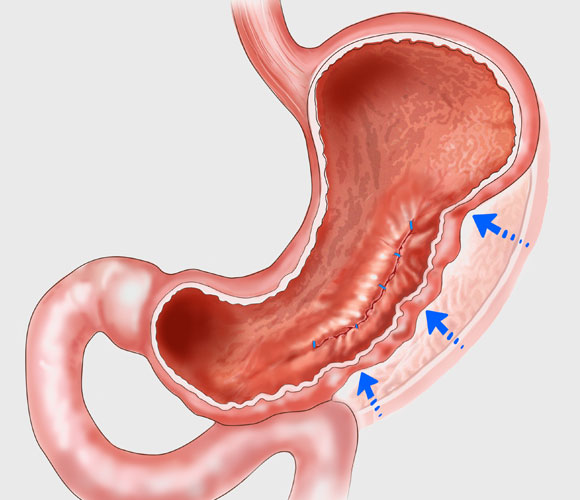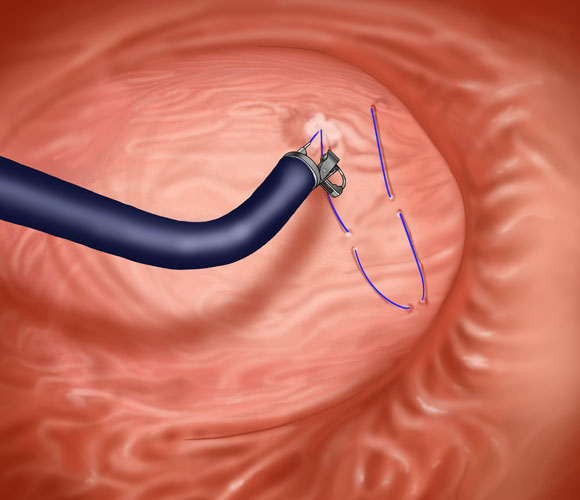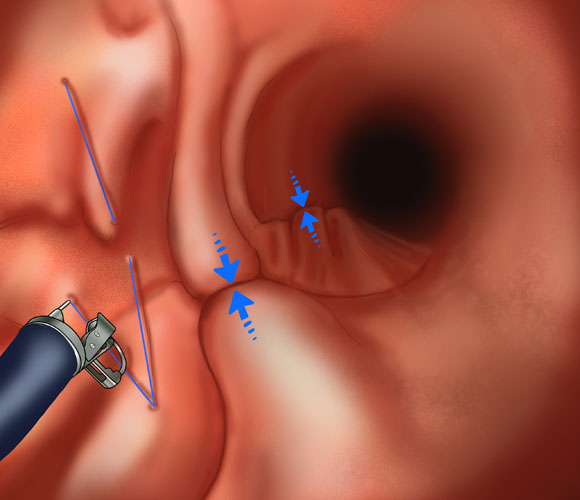


ENDOSCOPIC GASTROPLASTY OR ENDOSLEEVE
PRINCIPLE
This procedure allows for significant weight loss without surgery or scarring, involves less risk, with no anatomical changes.
At the IHU in Strasbourg, we offer a new non-surgical alternative, endoscopic gastroplasty (EGS), as well as traditional surgical treatments for obesity.
FEATURES
This new procedure is offered to people who want the benefits of obesity surgery with a less invasive non-surgical endoscopic procedure.
The choice between conventional bariatric surgery and an endoscopic procedure – Sleeve Endoscopic Gastroplasty (SEG) will depend on your personal assessment of the risks and benefits as well as your medical and surgical history.
SEG is less invasive with faster recovery and can even be performed on an outpatient basis in specific cases. This procedure is new, and little data is available on long-term results, which is the case for any innovative procedure.
Finally, although it is not a temporary procedure, endoscopic gastroplasty is reversible and may allow, in case of insufficient results, to refer to the performance of a classical bariatric surgery. Moreover, if necessary, it can be repeated and “adjusted” to further reduce gastric volume.
WHO IS THE SEG INTENDED FOR? ?
Apart from research protocols, this procedure can be envisaged in obese people (body mass index equal or superior to 35 kg/m2 with comorbidities or 40 without comorbidities) who do not manage to achieve weight loss despite medical follow-up and physical activity.
SEG is also indicated in people who cannot have surgery for medical or surgical reasons (history of abdominal surgery) or in patients who do not wish to have conventional surgery to treat their obesity.
SEG is not indicated in people who are overweight (not obese).
In all cases, a pre-operative assessment will determine whether this procedure can be offered to you.
SEG, like conventional bariatric surgery, remains a tool that will be effective if you implement a change in lifestyle and diet under strict medical supervision.
To be a candidate for SEG, certain conditions are necessary:
- age >18 years old
- body mass index ≥35-40 kg/m2 in the presence of comorbidities
- body mass index greater than 40 kg/m2
- accept pre- and post-operative medical follow-up
Endoscopic gastroplasty cannot be performed in some cases:
- digestive haemorrhages
- hiatus hernia of more than 3 cm
- history of major surgery on the esophagus and stomach
WHAT HAPPENS DURING SURGERY? ?
SEG allows a reduction and internal shortening of the stomach to significantly reduce its capacity and slow its emptying. It is performed under general anesthesia using an endoscope (flexible tube allowing internal vision) equipped with an endoscopic suture system. The endoscope is inserted into the stomach through the mouth. Several sutures will be placed according to a specific pattern from the bottom to the top of the stomach. By tightening these sutures, the gastric wall folds like an accordion, reducing the available volume.
There is therefore no anatomical modification of the stomach, only its wall has been sutured to give it the look of a sock. The weight loss mechanism is based on the strong reduction of the stomach’s capacity and the action on gastric emptying which is very much slowed down by the change in stomach morphology. Food arrives in the upper part of the stomach before slowly moving down through the narrowed portion to the remainder of the digestive tract.
The average operating time is about 90 minutes.
AFTER THE OPERATION
After the SEG is completed, you will be taken to the recovery room to monitor any complications. Returning home is possible the same day after recovery, or the next day. A liquid diet is established for a few days and then broadened. The management of obesity is based on the principles of therapeutic education of the patient. As with any obesity surgery, a suitable diet and regular physical exercise are necessary.
A multidisciplinary follow-up (surgeon, endocrinologist nutritionist, etc.) allows to control the efficiency, nutritional measures and the absence of metabolic problems.
ADVANTAGES
It is a simple, quick and uncomplicated operation.
The major advantage of this technique is that it is performed endoscopically without resection, without scars and without altering the anatomy.
EXPECTED WEIGHT LOSS
Endoscopic gastroplasty allows significant weight loss comparable to that obtained after gastric banding.
According to initial results in the medical literature, a loss of 30% to 60% of excess weight can be observed within six months after the procedure. In addition to weight loss, an improvement in co-morbidities (hypertension, diabetes, sleep apnea) is also observed.
These results will only be obtained if there is a change to a healthier lifestyle.
These changes require a permanent respect of an adapted diet and regular physical exercise for a good long-term result.
MAIN RISKS OF COMPLICATIONS
The first studies concerning endoscopic gastroplasty do not reveal any risk specific to the technique.
Some pain and nausea may be present during the days following the procedure.
Analgesics and anti-nausea medication are systematically prescribed.
However, this is a recent procedure with a limited number of cases and monitoring of long-term effects and risks is necessary.
WE HELP YOU ACHIEVE YOUR WEIGHT-LOSS GOALS
The surgical management of obesity is based on 4 axes: the surgical intervention, the preoperative and postoperative nutritional care, a preoperative and sometimes postoperative psychological assessment and follow-up, and a regular and sustained physical activity…

